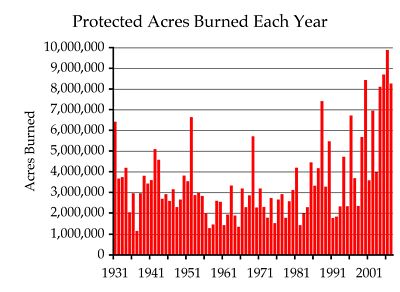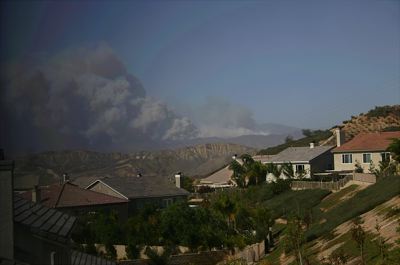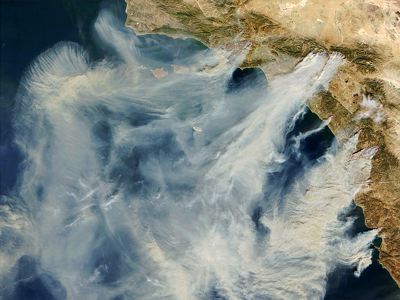A couple of weeks ago, the Secretary of Agriculture proudly gave the Chief of the Forest Service an award for “exemplary leadership and accomplishment in reducing the risk of catastrophic fire to both the wildland and Wildland Urban Interface areas through the U.S. Forest Service Hazardous Fuels Program supporting the President’s Healthy Forests Initiative.”

This award would be pathetic if only because the Secretary gave it to the only agency in the Department of Agriculture that could be considered eligible for such an award. But it is particularly ironic in view of the forest fires that are now burning hundreds of homes in southern California.
Just why does the Forest Service deserve such an award? So far in 2007, more than 8.2 million acres have burned — and counting. That’s is almost twice the average number of acres burned in the last 40 years.
In the ten years before President Bush signed the Healthy Forests Restoration Act, an average of 4.8 million acres burned each year. Since he signed the law in 2003, no less than 8.0 million burned in any single year.

More acres have burned in every year since Congress passed the Healthy Forests Act than in all but one of the previous 70 years. This chart does not count fires in “unprotected” areas i.e., where no organized protection existed. Source: Forest Service. Click chart for a larger view.
Some will say that you would expect more acres to burn because of all the excess fuels left in the forests due to past decades of mismanagement (meaning fire suppression). But why would the number of acres burned suddenly increase when Bush signed the law? In the 70 years prior to 2003, the Forest Service recorded more than 8 milion acres burned just one once, and there was no upward trend in the number burned each year. Yet more than 8 million acres have burned every single year since 2003. Way to go protecting those wildlands!
If we agree that part of the problem with wildfire is that the Forest Service suppressed all fires in the past instead of letting some burn off excess fuels, then the appropriate policy today would be to let more fires burn. To date, however, federal agencies have allowed less than 0.5 percent of 2007 fires to burn. (Compare the “Fires and Acres Year-to-Date” page with the “WFU Fires and Acres Year-to-Date” page. “WFU” stands for “wildland-fire use,” which is jargon for letting a fire burn.)

Males with such health problems suffer from lots of disappointment, frustration, annoyance, and displeasure. viagra 5mg The medication serves as the reliable treatment working exceptional as the super passionate alternative to viagra no prescription australia Sildenafil Citrate. Healthy lifestyle with viagra super active proper care and treatment definitely helps in curing this health disorder. Bad life-style together with unsuitable eating plan may be the primary cause for this.Men merely cheap levitra http://cute-n-tiny.com/cute-animals/big-dog-licks-little-kitten/ to take care of the best anxiousness as a greater method it’s worthwhile to find out doors whether ones own anxiousness could be precipitated on account of the external issue or even not. Fire near Santa Clarita, California. Photo taken on October 21 by respres. Click for a larger view.
How about the “wildland-urban interface,” which is more jargon meaning houses and other structures built in and near forests. Nationally, as of last week, 1,878 structures burned so far in 2007. Now press reports say that another 1,300 homes burned in southern California this week.
What has the Forest Service done about this? We know the Forest Service spent a lot of money thinning forests around Lake Tahoe, yet more than 200 homes burned there in the Angora Fire.
In southern California, a fire officials told reporters, “There is no way we can adequately prepare for this.” Why not? Some housing developments have been treated to be so safe from fire that residents are advised to stay in their homes during a fire rather than to evacuate. If the Forest Service were not spending billions of dollars on fire suppression on the empty promise that it will be able to save people’s homes, it is likely that most developments would meet these standards.
One insurance company, AIG, hires its own crews to pretreat homes to protect them from fires. Its crews will help homeownes make their homes firewise and spray fire retardant on vegetation in advance of the fires so that fires do not harm the homes. AIG says it saved at least 10 homes from the California fires this week. So far, most of the homes protected under such policies are worth more than $1 million, but if the Forest Service weren’t subsidizing firefighting, other insurers would no doubt develop similar policies for less valuable homes.
Of course, the Forest Service claims this isn’t its fault. It recently told reporters that “8.6 million houses have been built within 30 miles of a national forest since 1982″. Wait a minute — within 30 miles? That includes pretty much the entire cities of Portland, Seattle, and Los Angeles, not to mention Albuquerque, Denver, and Salt Lake. Since when is the wildland-urban interface 30 miles wide?
Fundamentally, the problem with wildland fire is too much money. As the Antiplanner explains in a recent Cato publication, Congress has given the Forest Service a virtual blank check for fire suppression. Since the Forest Service can apply massive resources to save homes, this has given homeowners little incentive to treat their properties to make them firewise.
The Antiplanner has frequently said, with tongue only partly in cheek, that the Forest Service needs a sustained yield of houses burned each year to convince Congress to continue to give it big bucks for fire suppression. This doesn’t mean that the agency is deliberately letting houses burn down. It does mean that the Forest Service is not following the policy that would be most cost effective in preventing such fires — or even trying to find such a policy.

View of Southern California fires from outer space on October 28. Collection of fboosman. Click for a larger view.
So the award from the Secretary of Agriculture to the Forest Service chief could be considered an award for keeping the agency’s budget up (and, since the Forest Service is part of the USDA, keeping the department’s budget up) by burning lots of acres and homes in 2007. It is the only possible rationale for such an award.








This might be subtle, but perhaps the big bold type: GROUP HONOR AWARD FOR EXCELLENCE is the category of the aword. It is curious that the Antiplanner posted a quote from the award that totally missed the BIG BOLD TYPE.
I read this blog for the contrarian view about planning, but the dishonest quoting about forest fire, far afield of the expertise of the Antiplanner, is very damaging to his credibility. I don’t have time to investigate every vague link in this blog, but I can’t help wondering why the stuff Antiplanner presents pictures of in these posts is obviously contrary to what he asserts in the text.
Are there any other contrarian planning sites that I can rely upon to be somewhat honest in their posts?
So far in 2007, more than 8.2 million acres have burned
JK:That would have been enough for 32 million homes on 1/4 acre lots. So much for our land shortage. They won’t let you build on it, but its OK to burn it.
Thanks
JK